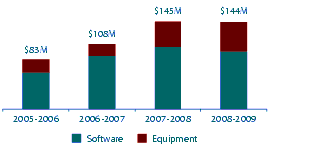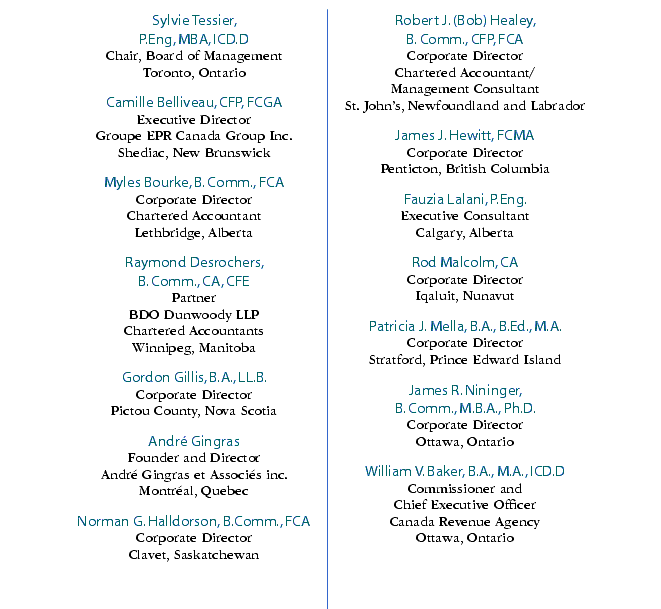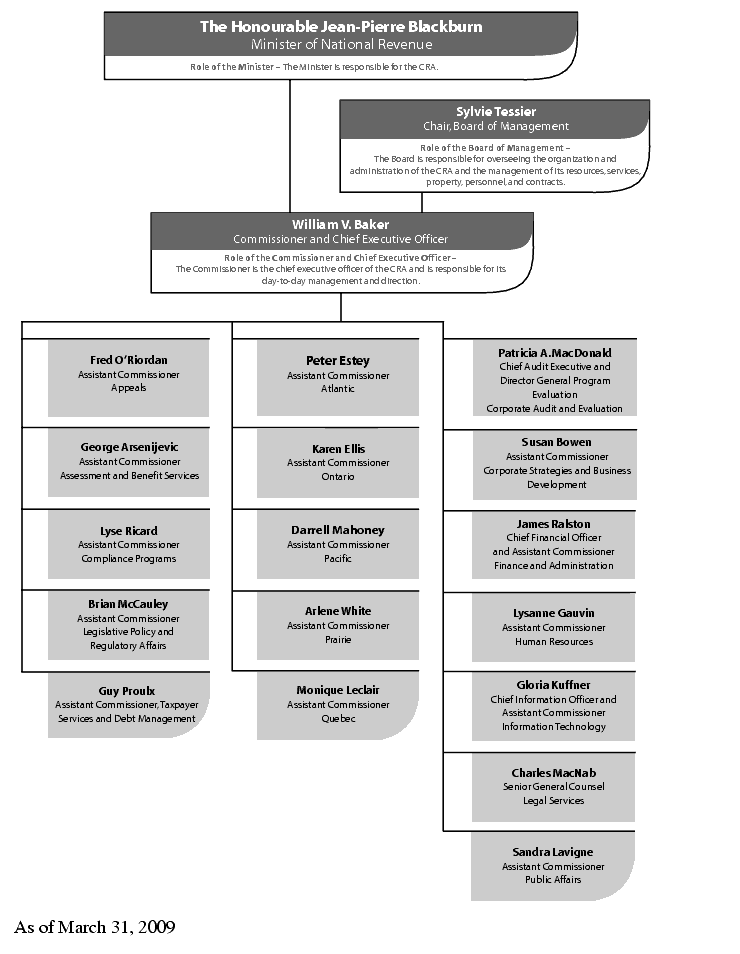Common menu bar links
Breadcrumb Trail
ARCHIVED - Canada Revenue Agency
 This page has been archived.
This page has been archived.
Archived Content
Information identified as archived on the Web is for reference, research or recordkeeping purposes. It has not been altered or updated after the date of archiving. Web pages that are archived on the Web are not subject to the Government of Canada Web Standards. As per the Communications Policy of the Government of Canada, you can request alternate formats on the "Contact Us" page.
Section III: Supplementary Information
Statement of Management Responsibility
We have prepared the accompanying financial statements of the Canada Revenue Agency according to accounting principles consistent with those applied in preparing the financial statements of the Government of Canada. Significant accounting policies are set out in Note 2 to the financial statements. Some of the information included in the financial statements, such as accruals and the allowance for doubtful accounts, is based on management’s best estimates and judgments, with due consideration to materiality. The Agency’s management is responsible for the integrity and objectivity of data in these financial statements. Financial information submitted to the Public Accounts of Canada and included in the Agency’s Annual Report is consistent with these financial statements.
To fulfill its accounting and reporting responsibilities, management maintains sets of accounts which provide records of the Agency’s financial transactions. Management also maintains financial management and internal control systems that take into account costs, benefits, and risks. They are designed to provide reasonable assurance that transactions are within the authorities provided by Parliament, and by others such as provinces and territories, are executed in accordance with prescribed regulations and the Financial Administration Act, and are properly recorded to maintain the accountability of funds and safeguarding of assets. Financial management and internal control systems are reinforced by the maintenance of internal audit programs. The Agency also seeks to assure the objectivity and integrity of data in its financial statements by the careful selection, training, and development of qualified staff, by organizational arrangements that provide appropriate divisions of responsibility, and by communication programs aimed at ensuring that its regulations, policies, standards, and managerial authorities are understood throughout the organization.
The Board of Management is responsible for ensuring that management fulfills its responsibilities for financial reporting and internal control and exercises this responsibility through the Audit Committee of the Board of Management. To assure objectivity and freedom from bias, these financial statements have been reviewed by the Audit Committee and approved by the Board of Management. The Audit Committee is independent of management and meets with management, the internal auditors, and the Auditor General of Canada on a regular basis. The auditors have full and free access to the Audit Committee.
The Auditor General of Canada conducts an independent audit and expresses opinions on the accompanying financial statements.
William V. Baker
Commissioner and Chief Executive Officer
James Ralston
Chief Financial Officer and Assistant Commissioner, Finance and Administration
Introduction
This section of the CRA Departmental Performance Report 2008-2009 provides the details of the Agency’s resource management performance for the purpose of reporting to Parliament on the use of appropriations in 2008-2009. This complements the information provided in the spending profile sections under each Program Activity and satisfies the reporting requirements set for departmental performance reports.
Financial reporting methodologies
The CRA’s funding is provided by Parliament through annual appropriations (modified cash accounting basis) and the CRA reports its expenditures and performance to Parliament, together with details on the management of Parliamentary appropriations on the same basis. In addition to the above reporting requirements, the CRA is also required to prepare its annual financial statements in accordance with the accounting principles applied in preparing the financial statements of the Government of Canada (full accrual accounting basis). Accordingly, the audited Statement of Operations – Agency Activities that can be found on the Canada Revenue Agency website at http://www.cra-arc.gc.ca/gncy/nnnl/menu-eng.html includes certain items such as services received without charge from other government departments and federal agencies. A reconciliation can be found on the CRA website at http://www.cra-arc.gc.ca/gncy/nnnl/menu-eng.html.
Activities of the Agency
The Financial Statements – Agency Activities reports $3,804.9 million as total Parliamentary appropriations used (Note 3 b in the CRA Annual Report to Parliament 2008-2009 shows the reconciliation to the net cost of operations). The difference from the $4,198.7 million reported in this section is explained by four items reported in the Financial Statements – Administered Activities: the payments to provinces under the Softwood Lumber Products Export Charge Act, 2006, $180.5 million; the Children’s Special Allowance, $211.8 million; the payments under the Energy Costs Assistance Measures Act, $0.5 million, and the Relief For Heating Expenses, $0.9 million (part of Vote 1, Program Expenditures).
Overview
For 2008-2009, Parliament approved $3,737.4 million through the Main Estimates, as shown in CRA’s 2008-2009 Report on Plans and Priorities.
The 2008-2009 Main Estimates were adjusted to include:
- $180.5 million for the Statutory Payments related to the 2006 Canada/US Softwood Lumber Agreement;
- $134.9 million for the carry-forward from 2007-2008;
- $84.0 million for maternity and severance payments;
- $74.5 million for the single administration of corporate tax for the Province of Ontario;
- $58.3 million for increased Respendable Revenue mainly for information technology services provided to Canada Border Services Agency (CBSA);
- $46.0 million for Collective Agreements;
- $33.1 million for Budget measures arising from the 2007 and 2008 Federal Budgets;
- $22.0 million transferred from Public Works and Government Services Canada (PWGSC) for accommodation services;
- $19.9 million for Budget measures arising from the 2007 Economic Statement;
- $7.1 million for the Foreign Convention and Tour Incentive Program;
- $6.0 million for the Government advertising programs;
- $2.7 million for Court Awards and Crown Assets Disposal;
- $1.2 million transferred from Public Health Agency for the advertising campaign on the Children’s Fitness Tax Credit;
- $0.5 million for the payments under the Energy Costs Assistance Measures Act;
- $1.1 million for Crown Agents across Canada – Office of the Director of Public Prosecutions; and
- $0.2 million for other minor adjustments.
These increases were offset by the following reductions:
- $17 million for the employee benefit plans costs;
- $14.2 million for private collection agencies;
- $7.1 million for statutory Children’s Special Allowance payments; and
- $0.4 million transferred to the Treasury Board Secretariat for the continued implementation of the Public Service Modernization Act and to the Public Service Human Resources Management Agency to support the National Managers’ Community.
This resulted in total approved authorities of $4,370.7 million for 2008-2009, representing an in-year increase of 16.9% over the Main Estimates.
Of the $4,370.7 million total authority, CRA’s actual spending totalled $4,198.7 million resulting in $172.0 million remaining unexpended at year-end. After deducting unused resources related to the proposed Offshore Trusts initiative and Public Opinion Research savings, the remaining $147.1 million is available for use by the Agency in 2009-2010. This amount represents 3.4% of the total authority.
The $147.1 million carry forward to 2009-2010 will be directed primarily to selected strategic investments related to:
- Major project and infrastructure spending (Compliance Systems Redesign, Tax Free Savings Account, Major Tenant Services and Information Technology Infrastructure);
- Special purpose funding (Softwood Lumber, Charities Partnership and Outreach Program, Corporate Tax Administration for Ontario, Ministčre du Revenu du Québec for the Administration of the GST); and
- Other operational and workload pressures.
Revenues administered by the Agency
Total revenues administered by the CRA totalled some $287.5 billion, a decrease of 1.8% from the $292.9 billion administered in 2007-2008.
Financial Highlights
For the period ending March 31, 2009
Statement of Financial Position
For the period ending March 31, 2009
Statement of Operations
There are three significant program administration changes which have influenced the results in the Financial Statements.
1. Corporate Tax Administration for Ontario
Under the Memorandum of Agreement Concerning a Single Administration of Ontario Corporate Tax signed on October 6, 2006, the Governments of Canada and Ontario agreed to transfer the administration of Ontario corporate income taxes from the Ontario Ministry of Revenue (OMoR) to the Canada Revenue Agency (CRA) starting in the 2009 taxation year. The CRA received $210.5 million of Federal Government funding over four years (2006-07 to 2009-10) for developmental and transitional costs relating to this initiative. Of this amount, $61.3 million was spent in fiscal year 2008-2009.
To date, the Corporate Tax Administration for Ontario initiative has met all its key milestones. The CRA began receiving blended federal and provincial installment payments from corporations in February 2008. On April 3, 2008, the majority of the administration of Ontario’s corporate income tax was transferred to the CRA for taxation years prior to 2008. The CRA started providing integrated audits and other related activities, such as rulings, interpretations, objections and appeals for 2008 and prior taxation years. Over 300 OMoR employees transferred to the CRA to assist with this additional workload.
All necessary agreements are now in place for the CRA to administer the harmonized T2 Corporation Income Tax Returns, starting in 2009.
2. Investment in Information Technology (IT) systems
Over the course of fiscal year 2009, the CRA had several large-scale projects that required substantial investments in the development of IT systems. Combined with the acquisition of IT hardware, the Agency has invested $144 million in IT related capital assets this fiscal year.
The value of these new capital assets has been offset by slightly higher depreciation in the year. Large-scale IT projects, by nature, generally require multi-year investments. These incremental investments add to the overall capital assets of the CRA as they occur, however, the associated depreciation of these assets only commences once a project is completed and the system enters production. This contributed to the increase of CRA’s depreciation in fiscal year 2009 as completed systems entered production mode and became eligible for depreciation. The total depreciation claimed by CRA in 2009 was $88 million.
The following figure outlines investments in information technology that have been accounted for as capital assets in the last four years.
Figure 12: Information Technology Investment in Capital Assets

3. Increase in non-tax revenue
The CRA financial statements demonstrate a noticeable increase in non-tax revenue of $58 million. The increase is attributable to the provision of IT services to the Canada Border Services Agency and administration fees charged to the province of Ontario relating to the Corporate Tax Administration for Ontario and to the province of British Columbia for the British Columbia Climate Action Tax Credit and Dividend.
Analysis of Net Cost of Operations
The Agency’s 2008-2009 net cost of operations increased by $348 million from 2007-2008. Agency expenses totalled $4,434 million in 2008-2009 (2007-2008 – $4,028 million). When adjusting for non-tax revenue of $538 million (2007-2008 – $480 million), the net cost of operations amounts to $3,896 million, as illustrated below:
Table 1: Details on the net cost of operations
Financial Highlights Chart
The Agency’s expenses are composed of 73% in personnel expenses (salaries, other allowances and benefits) and 27% in non-personnel expenses, as illustrated in the figure below.
Personnel expenses are the primary drivers for the Agency. A number of factors contributed to the net increase of $322 million for this type of expenses in 2008-2009. These include salary revisions pursuant to collective agreements provisions, the cost of other allowances and benefits, and increases in the staff complement due to new initiatives, such as the Corporate Tax Administration for Ontario and others announced in recent Federal Budgets.
In total, non-personnel expenses increased by $84 million. Significant elements of non-personnel expenses are made up of accommodations, transportation and communications expenses, which are, for the most part, linked to personnel expenses. The growth of $45 million in information technology costs are linked to increased amortization charges, investment projects, and infrastructure growth and renewal. Federal Goods and Services Tax administration costs by the Province of Québec have returned to more normal levels compared to the previous fiscal year in which the Province incurred higher costs related to the upgrade of their information technology systems.
Figure 13: Total Expenses by Type

Audited and Unaudited Financial Statements
For supplementary information on the Agency’s Audited and Unaudited Financial Statements, please visit www.cra-arc.gc.ca/gncy/nnnl/menu-eng.html
Electronic Tables
The following tables can be found on the TBS web site at http://www.tbs-sct.gc.ca/dpr-rmr/st-ts-eng.asp.
Table 1: Sources of Respendable and Non-Respendable Revenue
Table 2: User Fees / External Fees
Table 3: Details on Project Spending
Table 5: Details on Transfer Payment Programs (TPPs)
Table 8: Sustainable Development Strategy
Table 10: Response to Parliamentary Committees and External Audits
Table 11: Internal Audits and Evaluations
Rating Our Data Quality
In conjunction with the performance results ratings, we also assign each indicator a data quality rating.
For each indicator we use consistent approaches in evaluating the information derived from our data collections systems and all other sources. We rely upon CRA managers to vouch for the completeness of the records for data integrity purposes (i.e., data belongs to the same category, is collected for the same period, and by the same method). We examine data for relevance, formulas for accuracy, and other factors that must be considered. We also use comparable information from prior years for the purpose of historical comparison, which often appears in the CRA Departmental Performance Report. To ensure consistency, we perform the following tasks to verify that the information reported in our numerous reports is valid, reliable, and is accompanied by appropriate evidence:
- Validation: This is a process of verification to ensure that the data meets the requirements for its intended purposes. We review and evaluate data for completeness and plausibility (accuracy, timeliness, interpretability, coherence). We also identify contact information, check calculations, confirm system reliability (verifying the source of information), and note and address any errors.
- Data quality assessment: We apply a data quality checklist and review prior years’ data to assess the quality of data for each indicator.
- Electronic filing system: We store data in a database for easy reference and further analysis for other purposes.
- Physical filing system: We maintain physical files of the evidence collected from all sources to provide validation and assurance that our data quality ratings are accurate and supported.
We always endeavour to use the most appropriate and reliable data when evaluating our results. There are mainly two data sources for the CRA Departmental Performance Report: administrative data (normally communicated in aggregate or after some simple calculations are performed on them) and survey data. All data sources are validated for accuracy and a data quality rating of good, reasonable or weak as categorized below is applied to each indicator.
We believe that these three levels of data quality ratings provide a reasonable assessment of the reliability of the data. Generally, our data sources provide reliable information. In situations where the supporting data is too imprecise to draw firm conclusions, it is reflected in the data quality rating.
Data Quality Ratings
Service Standards at the CRA
Our service standards regime is a vital and integral part of our planning, reporting, and performance management processes. Meeting our service standards targets demonstrates that we are responsive to the needs of taxpayers and benefit recipients. This helps establish credibility in our operations and contributes to increasing the level of confidence that Canadians can place in government.
For supplementary information on the Agency’s Service Standards, please visit www.cra-arc.gc.ca/gncy/nnnl/menu-eng.html
The CRA Governance Structure
Board Membership
The Board of Management of the Canada Revenue Agency comprises 15 members appointed by the Governor in Council. They include the Chair, the Commissioner and Chief Executive Officer, a director nominated by each province, one director nominated by the territories, and two directors nominated by the federal government. Members of the Board bring a private-sector perspective and business approach to management and, in this regard, have been championing a significant agenda for change within the CRA.
The following list shows the Board membership as of March 31, 2009.

Organizational Structure

